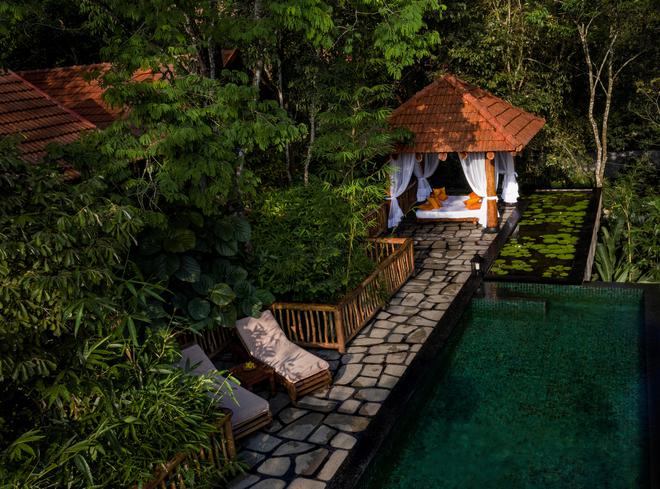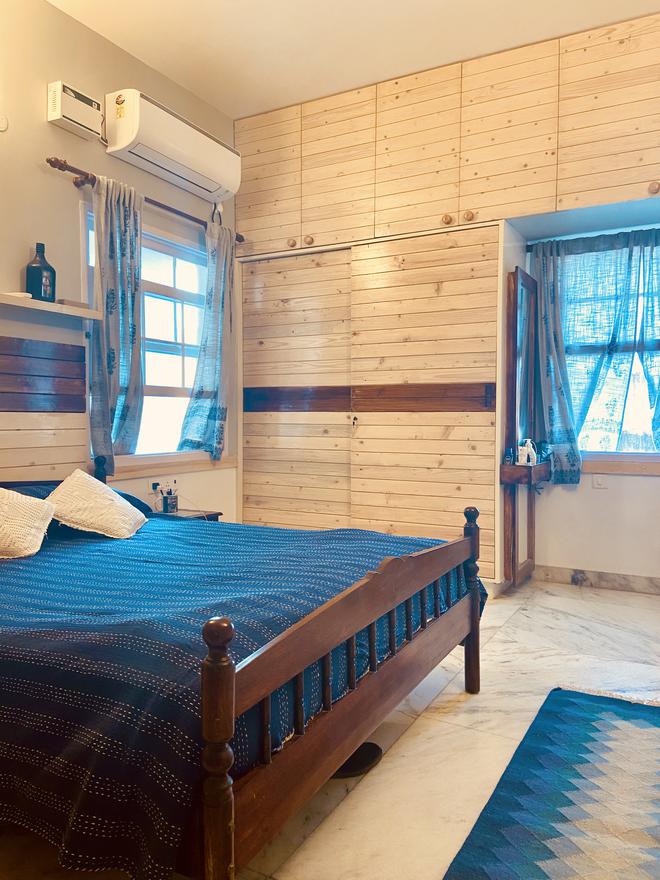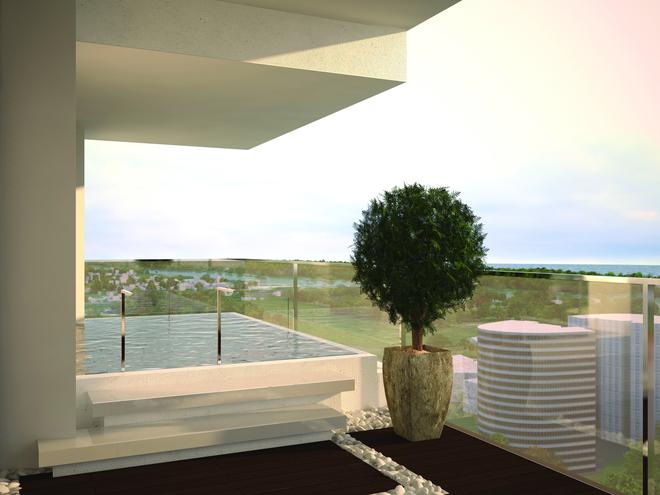In February this year, Indu Champati and her husband Sarath, sold their home in Suvidha Retirement Village, on the outskirts of Bengaluru, and moved into Stone Lodges, a cluster of luxury private residences spread on Wayanad’s forested hillside. “We purchased the home (designed by Earthitects, the in-house design studio of Evolve Back Resorts) back in 2017 as Sarath, a naturalist, and I were keen to move away from the city. Sarath had worked with the team for several years, but the trust factor aside, we were sold on the home’s location amidst a coffee estate, and the architectural belief,” says Champati, who runs The Bodhi Tree, a travel company that curated wildlife and nature tours across India. For the couple, who are now in their 60s, living close to nature was always a priority. “We had moved into Suvidha from our home in Whitefield, Bengaluru. Today, we shuttle between Whitefield and Kalpetta.”
The Champatis are among India’s growing tribe of luxury home owners who have been nudged further by the pandemic. Scenic locales, homes built using traditional materials and state-of-the-art technology are just a few of the features luring them and the tribe is only increasing.
Amit Goyal, CEO, India Sotheby’s International Realty, says that their recently conducted Sotheby’s International Realty Outlook 2022 highlighted that an overwhelming 67% per cent of respondents said they would look to buy luxury residential real estate this year. As many as 29% of high net-worth individuals (HNIs) and ultra HNIs (uHNIs) expressed their desire to acquire a holiday home. Which is a steep rise considering pre-lockdown numbers. “Prior to the pandemic, not more than 5-6% of our HNI clientele was searching actively for a holiday home,” he says. What he also highlights is that “reconnecting with nature” emerged as the top priority amongst luxury home buyers. Not surprising, given the pandemic having forced people back to their hometowns and resulted in a shift in mindset to embrace all things natural.
Sustainability in focus
Take for instance Earthitects Private Residences, where the reverse urbanisation design philosophy takes centrestage. Cherian Karippaparambil, one of the founders, says the future of living is definitely away from the concrete jungle. Having launched their first private residences at Wayanad in 2016, and in Coorg soon after, he explains how each home is built “around Nature rather than on it” and takes two years to complete. “We ensure that the existing trees, boulders and other natural features are preserved while we craft the private residences around it. We mostly use natural materials such as clay roof tiles, eucalyptus poles, custom-finished granite for counters and stone deck floors, which are available locally,” says Karippaparambil. Now working on a similar project in Kabini, he adds that he’s seen an increased demand for such secluded spaces post-lockdown.

Anupama Mohanram, co-founder of Chennai-based Green Evolution, says she has worked on more luxury residences over the last 3-4 years than she has ever done in the past. “When earlier independent, luxury homes were about 25% of our project type, now it is about 60%,” says the architect who has recently completed two villas in Chennai and one in Thiruvannamalai (₹1.75 crore).
“We have seen a demand for luxury homes with a focus on sustainability especially over the last two years. People are realising the fragility of our environment and are willing to spend on eco-friendly material and technology. They are also seeing a need to build independent homes with plenty of open space around rather than own apartments,” says Mohanram. With the firm now getting enquiries from Andhra Pradesh, Maharashtra, Kerala and West Bengal too, she says multi-family homes (typically two to three floors) are gaining popularity too.

So what are the non-negotiable eco features in demand? Abundant natural light and ventilation tops the list, says Mohanram, along with eco-friendly materials, and infrastructure for urban gardening with automatic irrigation. Other demands include clean energy systems such as solar photovoltaics (SPV), building integrated photovoltaics (BIPV) systems combined with smart home technologies such as sensors and smart metering systems. “Sustainable water management including comprehensive rainwater harvesting and waste water treatment / reuse systems are a priority too.” An equally important factor that today’s buyers look for is maintenance, adds Karippaparambil. “At Earthitects, we ensure that our homeowner’s habitat and the Estate is maintained even in their absence.”
Why luxury?
The aspiration of owning a luxury home aside, what is prompting buyers in India? Key reasons for this trend are low house price levels in suburban locations of top cities like Mumbai, NCR and Bengaluru, low home loan interest rates coupled with the need for a home that accommodates work and study from home needs, says Vivek Rathi, Director-Research at Knight Frank India. “Besides, appreciation for product quality both in terms of quality of construction and preference for amenities like open and green spaces, health, sustainability come to the fore for the home buyer,” he says.
Several experts say that initially, the demand for luxury homes was driven by those looking for an opulent vacation home. Over the years, dynamics have shifted, as have market conditions, and the buyer today is looking for spacious first homes too. “Buyers are now going from living in a 1.5 or 2BHK to living in a 3BHK or 4BHK. Lifestyles also shifted with work-from-home and hybrid workstyles, and many moved into bigger houses to integrate a home office. In several cases, people are buying larger homes in the form of apartments to accommodate large families. ‘Jodi’ flats — wherein two flats on the same floor are combined — are gaining prominence,” says Ram Raheja, Director at S Raheja Realty, who recently launched a premium residential luxury project in Khar West, Mumbai.

With India having the highest strength of young individuals in their early 30s, he says many are looking up luxury properties and wanting to invest in a home. “Millennials have a high value for privacy and security, hence they are consequently looking for luxury homes as first homes offering a comfortable lifestyle.”
Athangudi tiles and art installations
Indian luxury buyers today are keen to experiment with locally available skills and materials as well as traditional artisanal craft and bespoke detailing, says Ankur Choksi, Principal, Studio Lotus, a firm known for its ‘conscious approach’ to design. “In terms of spatial planning, inside-outside connections are redefining the way we live, with jaalis, enclosed verandahs and inner courtyards bringing in abundant natural light while providing shade, enabling cross ventilation, and serving as temperature regulators,” says the architect, who recently redeveloped a former guest house in Lutyens’ Delhi into a contemporary single-family residence. He talks about how homeowners are embracing the notion of conscious living, through upcycling, recycling, and minimising energy usage. Old furniture is often repurposed, and materials are being vastly upcycled. “Contemporary homes are being looked at as repositories of memories, shaped by family heirlooms, photo montages, paintings and keepsakes amassed over time,” he says.
Take for instance the Lutyens’ Delhi project wherein the brief required minimum alterations to the structure’s original Neoclassical vocabulary. “The scale of the spaces was thus reduced, and the functions redistributed to create an intimate quality, with flexible programs that evolve with time — ideal for single-family living. This was achieved by selectively shifting walls, reconfiguring ceiling levels and reorganising the sequence of entrances. Inside, the home features a rich tapestry of paintings, sculptures, and art installations,” says Choksi.

Currently working on a traditional courtyard style villa on ECR in Chennai (₹1.65 crore), Mohanram says she is seeing a shift towards traditional design aspects that reflect our culture. Her go-to building materials that align with this philosophy include terracotta bricks and blocks (that can be exposed on the exterior if needed), natural stones such as granite, kota for flooring, Athangudi tiles, windows with double glazing, solar control glass (cuts out heat but lets in light), seasoned, salvaged wood, and repurposed heritage furniture.
Minnie Bhatt, Founder of Mumbai’s Minnie Bhatt Design says people are now more focused on the value brought in by the product or the design. “They are more conscious of their spaces and how they are built,” says the designer who recently worked on the interiors of Imperial Edge, a luxury home project in Mumbai’s Imperial Towers. “The home is adorned in wooden accents and indoor plants. I have also used popular materials such veneer, marble and brass,” says Bhatt who is known to use natural stones, imported marble or onyx, and brass for her interior finishes, and is now working on a luxe project at Lodha World Tower.

The pandemic has also accelerated digitisation and the emerging segment of the UHNI (ultra-high-net-worth individuals) category is also driving the luxury property segment. Tech-savvy customers in metropolises now look for voice-controlled features, automatic temperature and light control, hi-tech surveillance and security systems, and the latest tech advancements loaded in their homes, says Raheja.
Down South, T . Chitty Babu – CEO Akshaya Private Limited, points to a new trend. Given the dearth of land in the city centres, he says developers have turned to the sky, and quite literally. “Sky high luxury condominiums with large floor plates i:e a sky villa with private pools, view decks, private lobbies, and staff quarters are most in demand in the uber luxury segment. They offer privacy, better security and ample natural light that a villa at ground level would lack,” says Babu, known for his luxe projects Tango, Levelup, and Abov (that has sky villas of approx. 6,700 sq.ft.) in Chennai.
The second home
Aside from buyers betting big on going green, it’s important to note the key demographic investing in these homes. Unlike the pre-lockdown years (between 2008 and 2018), what we are seeing now is that end-users are largely driving the luxury market. “For many affluent denizens, second homes became a tantalising vision of alternate shelter in the time of a storm. Many were also hoping to own a second home within salubrious, green surroundings,” says Anuj Puri, Chairman, Anarock Group. For the HNIs like the corporate C-suite and start-up entrepreneurs, he says their sights are trained on sprawling luxury properties and farmhouses near cities as alternate living destinations. “These were largely priced at Rs. 10 crore onwards. Additionally, real estate has always been an important diversifier in HNI investment portfolios - now, amid a pandemic, it remains a reliably stable asset,” he says.
Goyal agrees. While many HNIs have upgraded to bigger homes and are using them as their primary base, he finds that several have taken advantage of the market conditions to invest in second homes away from the madding cities — with destinations like Alibaug, Lonavala near Mumbai; Kasauli, Shimla in Himachal Pradesh; Dehradun in Uttarakhand gaining popularity. Goa, however, remains the top choice. “Business owners, CXOs and start-up founders who sold their equity stakes, also invested their capital gains in luxury real estate,” says Goyal.

Perhaps the most popular among these locales are the farmhouses at Chattarpur, Mehrauli-Gurgaon Rd (Sultanpur) in New Delhi that have seen high demand. As per Anarock Research, the average prices here start at around ₹10 crore and go all the way up to a whopping ₹100 crore or even more depending on the size, features and location of the property. “The number of average monthly transactions went up from 2-3 in the pre-COVID era to 10-12 post the lockdown,” says Puri, adding that luxury hotspots in south-central Mumbai also saw a significant uptick in demand since the pandemic. “Deals have also been closed over ₹200 crore in some locations, most notably in Goa’s fabled beachfront and in the elite second home reserve of Aamby Valley.”
Trickle down effect
The ticket size segment above ₹10 million is identified as the top band in shared trends. “In Q1 2022 the concentration of this segment was 25% at the top 8 cities (including Mumbai, NCR, Bengaluru, Chennai, Pune, Ahmedabad) level sales, whereas a higher share at 40% for NCR and 32% for Hyderabad was witnessed in the period,” says Rathi. Considering the rising share of the segment, are the promising trends — green materials, reverse urbanisation, etc — impacting other housing segments too?
Mohanram sees sustainability becoming a focus in the affordable market, especially since the pandemic hit. “Our clientele is keen on eco-friendly materials, energy and water conservation, etc. but have budget constraints. We provide them with a choice of materials based on their cost, and also give them provisions for solar PV, sensors during planning, but let them phase these out as per their comfort,” she says, adding how clients up their budget by 5% to opt for green features. “The people who reach out to us want independent homes - they’d rather buy a small plot and construct a home rather than purchase an apartment. So, we have to work a lot trying to pick out cost-effective alternatives until we come up with the costing that works for them.”

Going by these trends, record sales figures, and architects booked for several luxe projects, the sector is only slated for a rise. Unlike some of the developed countries, where the price increase frenzy seems to be cooling off, in India, Goyal believes, we are at the start of a secular price rise. “We expect low-rise homes in the thriving urban centers, especially in Delhi NCR and Mumbai, and the vacation home destination of Goa, to be the outperformers of 2022,” he says.
As for Champati, who is content moving in and out of city life — she says she has “the best of both worlds” — if given a chance, she would move entirely to Kalpetta. “Now that we have gone through a pandemic, we yearn for the connection to Nature more than ever.”







